This recipe is a glimpse into how I research traditional Chinese dishes: through memory, firsthand tasting at the source, and flipping through old, often-out-of-print cookbooks. Most dishes don’t give me the luxury of all three, but with this one, I was lucky.
While dandan noodles have become the global icon of Sichuan noodle culture, they only scratch the surface. Ask a local in Sichuan about their favorite noodle dish, and you’ll get a dozen different answers—every city has its specialty, some of which remain unfamiliar even to Sichuanese from other parts of the province.
Yibin Burning Noodles, or Yíbīn Ránmiàn (宜宾燃面), are one of the dishes closest to my heart. Back in the early 2010s, when I was a college student in Chengdu, the city was (and still is) filled with small noodle shops serving ranmian. These were the places I turned to whenever I craved something cheap, quick, and flavorful. Most shops offered small portions— yi liang (一两), about 50g of noodles—and the norm was to order two bowls, mixing and matching spicy and mild, soup and dry, wontons and noodles. When I felt indulgent, I’d also add a rice cake dessert, draped in brown sugar syrup (lianggao, 凉糕).
Yibin Ranmian is a bolder and louder cousin of Dandan noodles. It’s a dry noodle dish tossed in chili oil and loaded with toppings: yacai (a Sichuan preserved mustard stem), toasted peanuts, ground sesame seeds, and scallion greens. Every strand is slicked with heat and fragrance, crunchy with texture. The most common version today is hongyou ranmian (红油燃面), or red burning noodles—but historically, there were other styles too: tangran (糖燃), made with lard and sugar, and baiyou ranmian (白油燃面), using just sesame oil and lard. Ranmian can be made with lard, and/or meat (hun ran, 荤燃) or without (su ran, 素燃), and thanks to its punchy, umami-rich toppings, it’s just as satisfying in its vegetarian form.
Yibin, the dish’s birthplace, is a city in southern Sichuan located at the confluence of the Min and Yangtze Rivers, known as “the first city on the Yangtze River” (万里长江第一城), historically a thriving hub for river transport. Like many iconic Sichuan dishes—hot pot included—Ranmian began as a meal to feed labor workers on the dock. The word “ran” (燃) means ignite or burn, and the name itself has several origin stories. Some say the noodles are so oily they could be set on fire (I tried; didn’t work). Others think the “burning” refers to the fiery heat in your mouth. Another theory: “ran” refers to the vigorous tossing of noodles with oil and toppings1. According to The Encyclopedia of Sichuan Cuisine2, ran might even originally refer to the sizzling sound when hot oil hits the seasonings—similar to you po mian—though that technique is rarely used now.
As a long-time fan, I finally made the pilgrimage to Yibin in winter 2023 with my parents. At Luerqian Ranmian, a humble roadside shop open since the 1980s, the owner told me they’ve upgraded their recipe over the decades and now serve something they call Jingcui Ranmian (精粹燃面), or "Quintessential Ranmian." It cost about one euro. He shared their tips for making great ranmian: shake the noodles well, use high-quality yacai and alkaline noodles.
Later, I uncovered a version of the dish in a vintage cookbook, Chinese Snacks: Sichuan Cuisine (《中国小吃 四川风味》), from the 1980s—the same one that led me to the Zhong dumpling recipe. I translated the ranmian recipe (you can download the PDF below to see the original recipe + translation), tweaked it slightly for the modern home kitchen, and it worked beautifully.
Yibin Burning Noodles (Yibin Ranmian, 宜宾燃面)
Ingredients
Nutty Chili Oil (makes enough for 4–6 servings)
60 g (2 oz.) vegetable oil or roasted rapeseed oil (caiziyou)
3 tbsp Sichuan chili flakes
1 tsp whole Sichuan peppercorns
1 knob of ginger, smashed
25g (¼ cup) walnuts
2 tsp sesame oil
1 tbsp pork lard (optional)
If using store-bought or ready-made chili oil, add a bit of sesame oil and pork lard for flavor.
For One Serving of Noodles
1 tbsp suimi yacai
1 tbsp skinless peanuts
1 tsp white sesame seeds
100g fresh thin wheat noodles with alkaline (or 80g dry)
2–3 tsp nutty chili oil
1 tsp light soy sauce
⅛ tsp MSG
1 tbsp zajiang meat sauce (optional, see recipe below)
1 tsp chopped scallion greens
Instructions
Make the chili oil: In a heatproof bowl, add chili flakes. Heat the vegetable oil until 230ºC / 450ºF, then turn off the heat (for neutral oil, about 200ºC/400ºF). Add ginger, Sichuan pepper, and walnuts. When the oil cools down to 150ºC / 300ºF, strain solids, pour oil over chili flakes, and stir. Mix in sesame oil and pork lard while the oil is still warm. Set walnuts aside.
In a small pan, toast sesame seeds until slightly golden, then transfer to a mortar and pestle to grind into a coarse powder, set aside. In the same pan, toast skinless peanuts until golden brown, and pound into small pieces (or use a knife to roughly chop them).
Wash and drain Yacai, then in a pan, add about 1 tsp of oil and fry until fragrant. Remove and set aside.
Cook the noodles: Set a big pot of water to boil, cook the noodles until al dente (30 seconds or 1 minute less than package instructions). Use a colander, or a big sieve, to remove the noodles and shake off vigorously to remove excess water.
Add to the bowl and dress immediately. For each bowl of noodles, add 2 tsp chili oil and toss until well combined. Then season with ⅛ tsp MSG and 1 tsp soy sauce for each bowl, and top with sesame and peanuts, yacai, and chopped scallion greens. Add blanched vegetables and ground meat sauce to your liking.
How to make ground meat sauce (makes for 4 servings)
Heat 1 tbsp of vegetable oil in a wok over medium heat, then add ground pork (or beef), breaking it apart with your spatula, and fry until it turns pale. Add 1 tbsp Shaoxing wine and 1/2 tsp white pepper, and cook for 2 minutes until the liquid evaporates. Add 1 tbsp minced ginger and 1 tbsp sweet flour sauce (tianmianjiang), and fry until the fat renders. Add 1/3 cup of stock or water and let it simmer for about 10-15 minutes until the liquid reduces. Remove from heat and allow it to cool to room temperature.
You can save any leftover meat sauce for future use, for hot and sour noodles, steamed egg and zajiang noodles.
Tips for the Best Ranmian at Home
Noodles
In Yibin, thin alkaline wheat noodles are used for a bouncy texture. The key is to shake off water after boiling and toss right away with oil. Overcooked or wet noodles will stick and clump.
I tested a range of noodles from my local Asian grocery store and landed on two favorites that are close to what I had in Yibin. Normally, I’d look for noodles that have “jianshui”(碱水) on the label, which means with added alkaline (the same I used for Sichuan cold noodles). Sometimes they’re labeled as 青田面干 (make sure to get the light yellow ones) or 热干面. If those aren’t available, any thin, chewy wheat noodles will work.
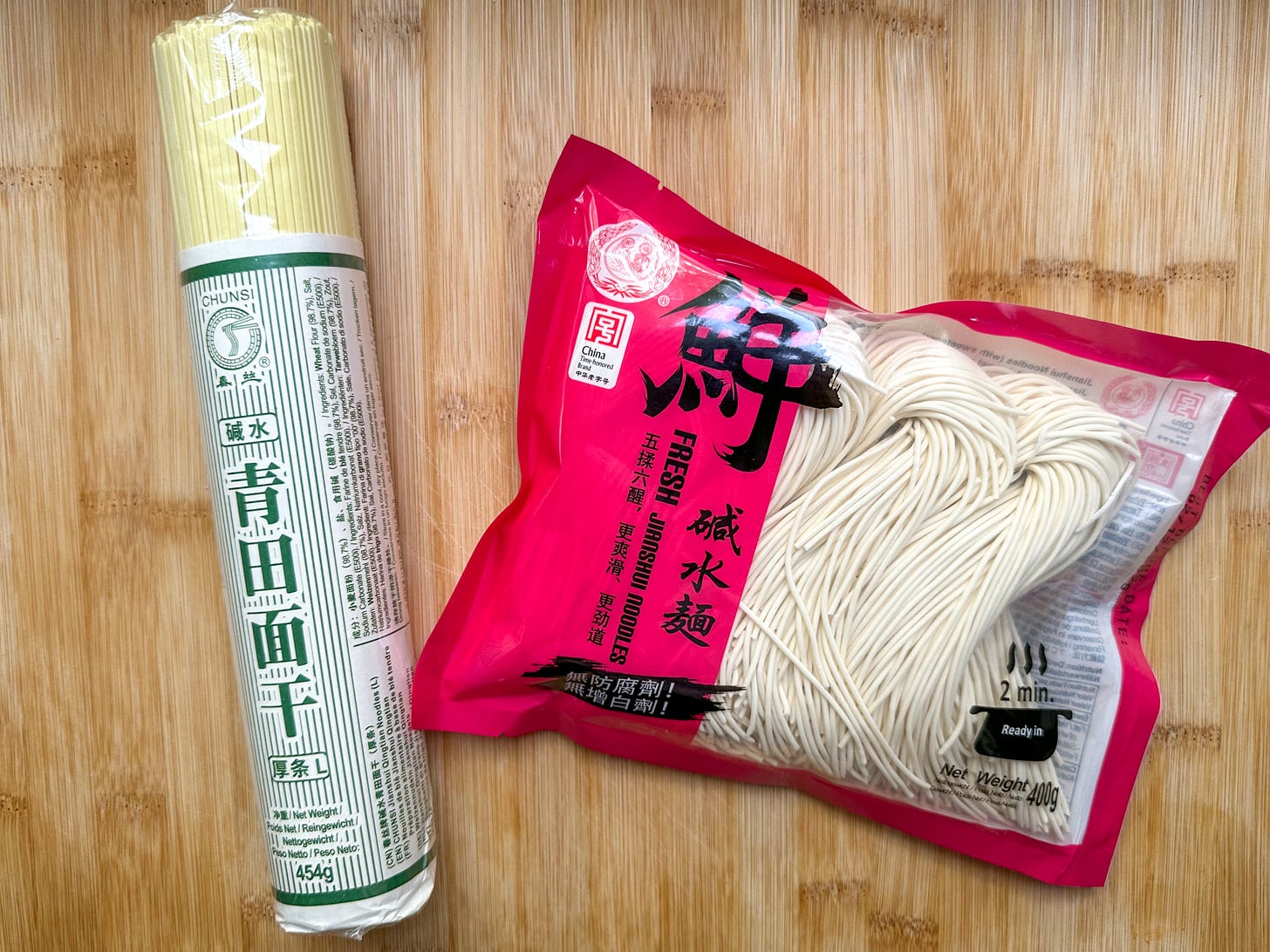
Chili Oil
This version uses walnuts for a nutty twist—something I hadn’t tried before but loved. Pork lard adds body and stickiness, and sesame oil adds aroma. You can also snack on the fried walnuts or chop them and add them to the toppings. The original recipe calls for caiziyou, roasted rapeseed oil that has an intense aroma. But you can also use neutral vegetable oil as a substitute.
In Sichuan, pork lard (rendered pork fat) is a staple in dumpling and noodle sauces. I used the cooking lard (Schweineschmalz) from a local supermarket in Germany, reduced the amount slightly from the original vintage recipe so it doesn’t solidify too much when cooled.
Of course, you can also use your homemade Sichuan chili oil if you already have it at hand.
Toppings and Seasonings
To keep the noodles satisfyingly dry, use watery ingredients like soy sauce sparingly—just a splash is enough. The dish is also easy to make vegetarian: simply skip the lard and meat sauce.
Toasted peanuts and sesame seeds can be prepared ahead of time, or use store-bought versions to save time (look for unsalted roasted peanuts and pre-toasted sesame seeds). Either way, I recommend crushing them into smaller pieces. The finer texture helps them cling to the noodles more evenly, mingling beautifully with the chopped yacai in every bite.
From the book «大师的菜: 地道川菜». A fun fact: ran (燃) also means “mingle” in the northeastern Sichuan dialect I grew up with.
“因此面淋热油时发出响声犹如燃烧,故名。”《川菜烹饪事典》1985

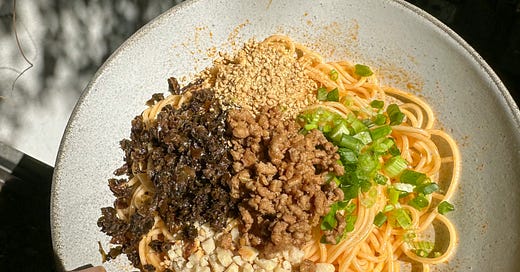


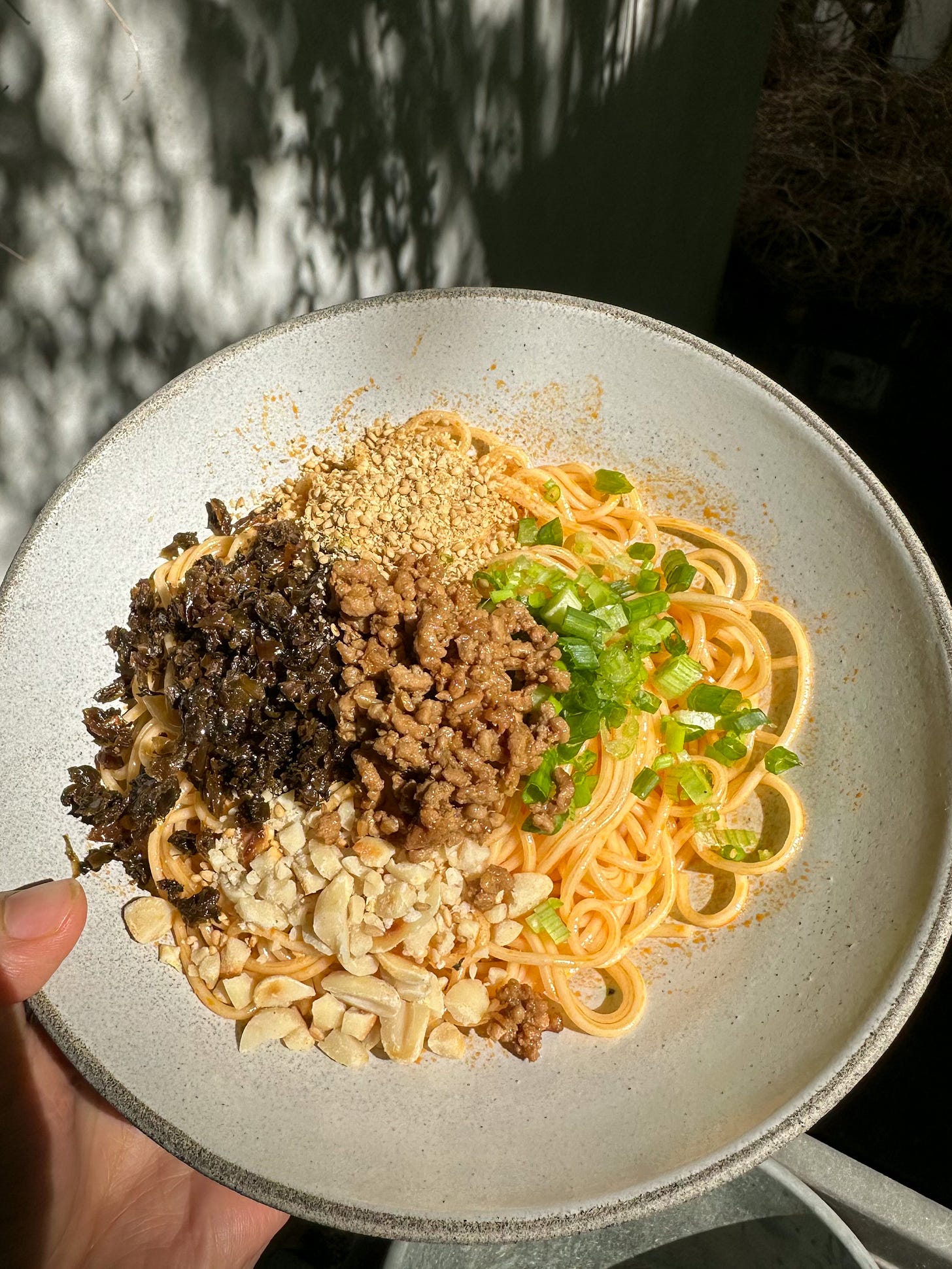
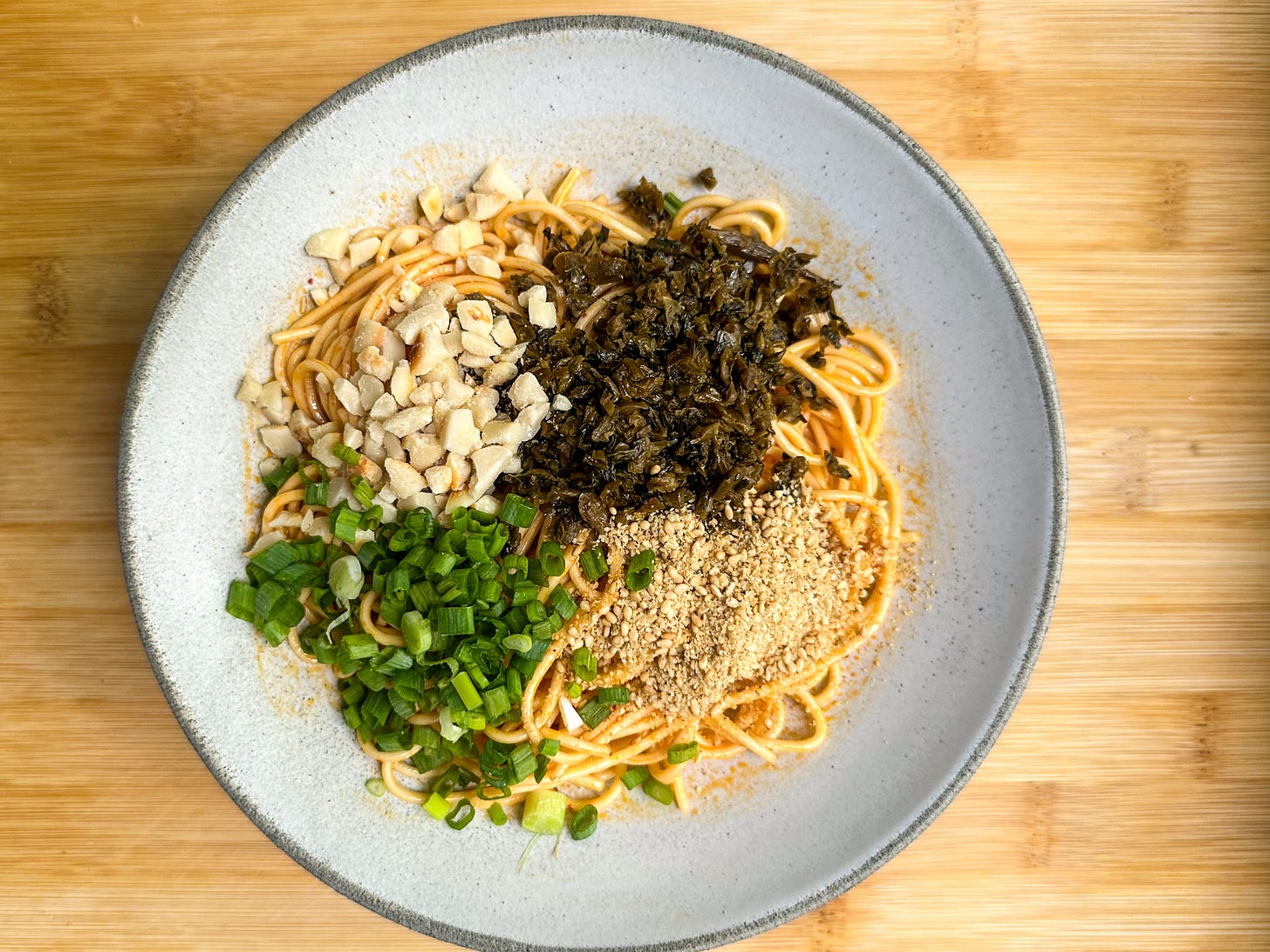


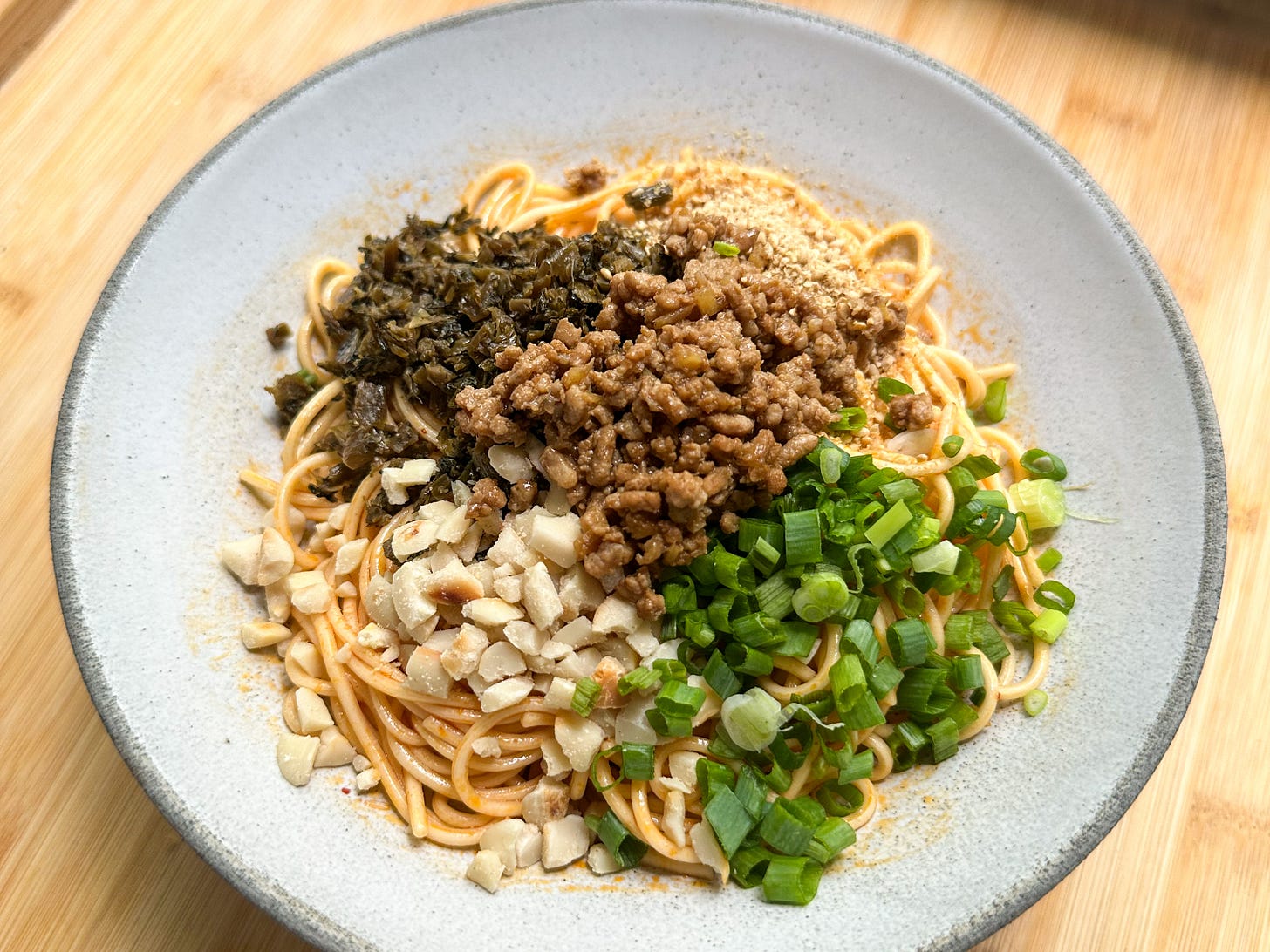
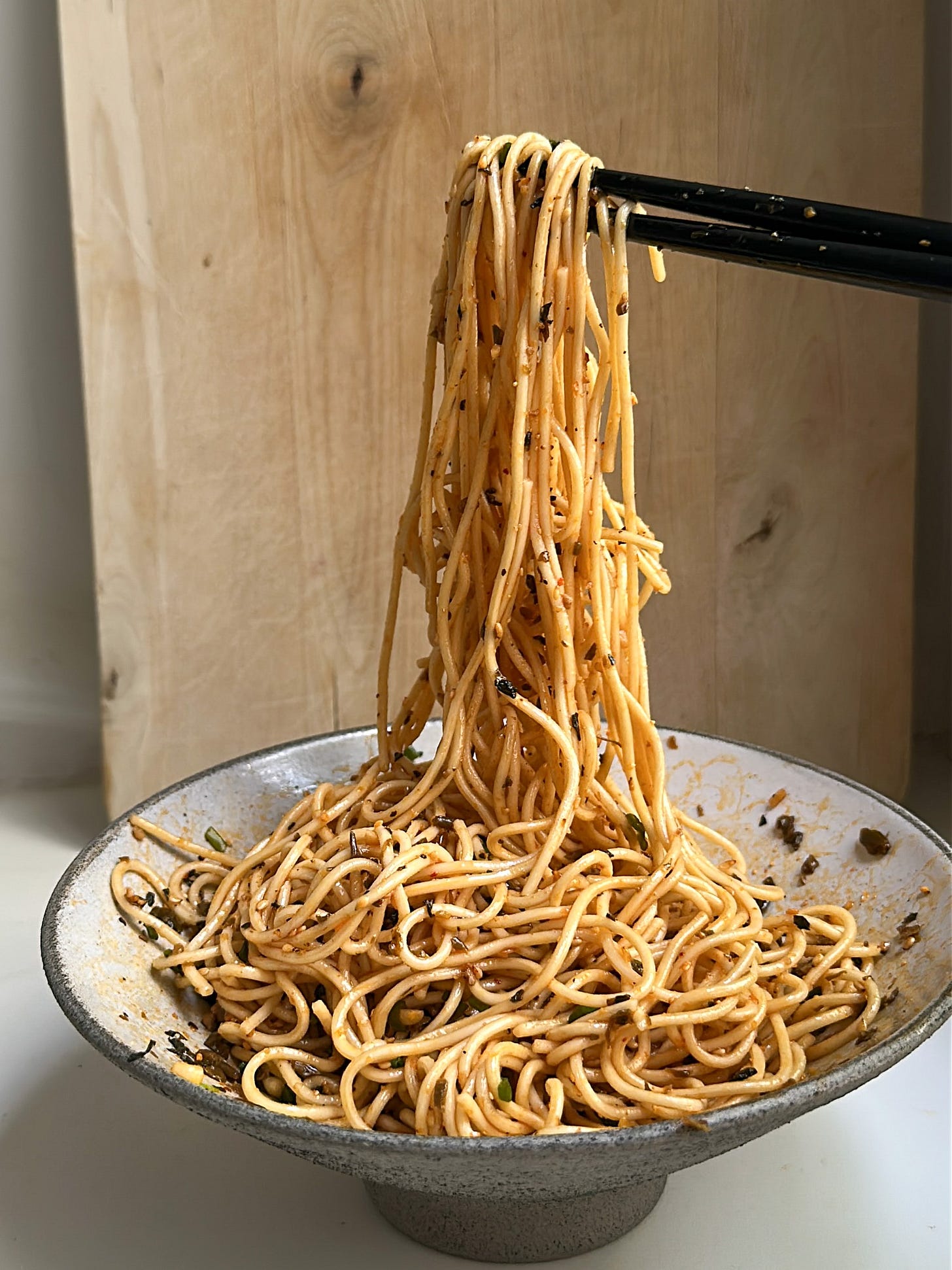
Great writing, great subject. 💖 Funny story, before we went to Chengdu and Chongqing to try spicy noodles, we were watching a CCTV documentary interviewing small noodle shop owners. My young son, maybe 8 at the time, turns to me and says, "Seems like if you're having trouble in your life, just open a noodle shop!" 😂😂
This is a great piece of food writing. The dish itself sounds like something that I must try. Thanks you.